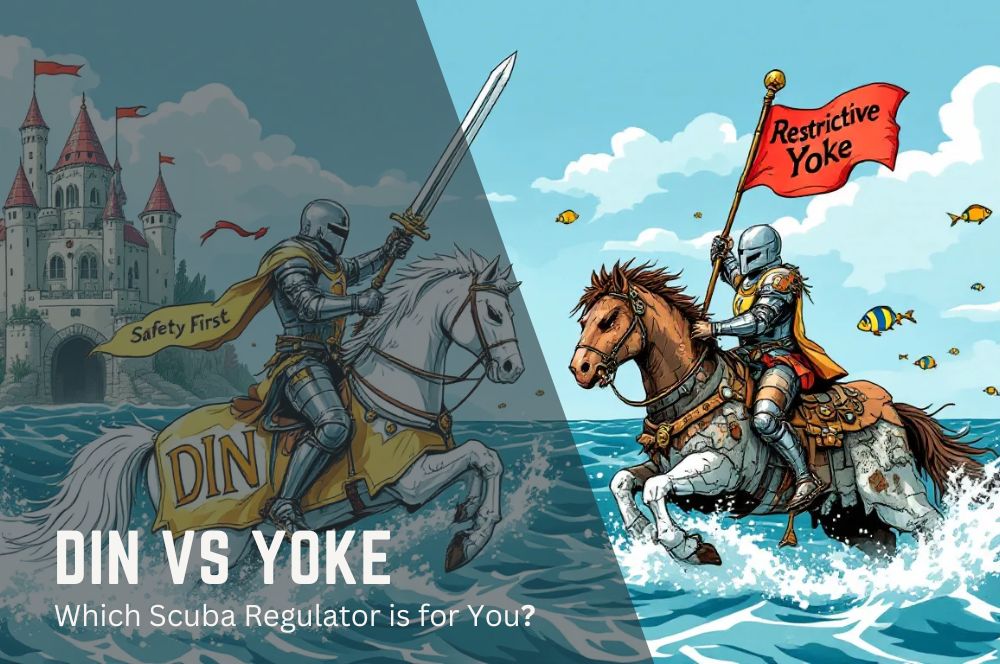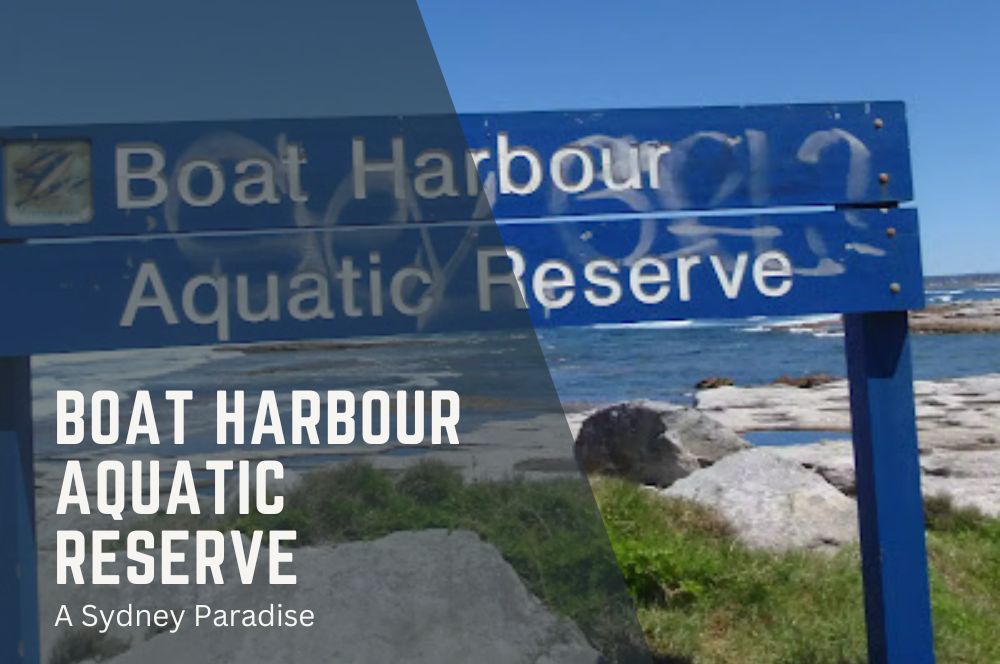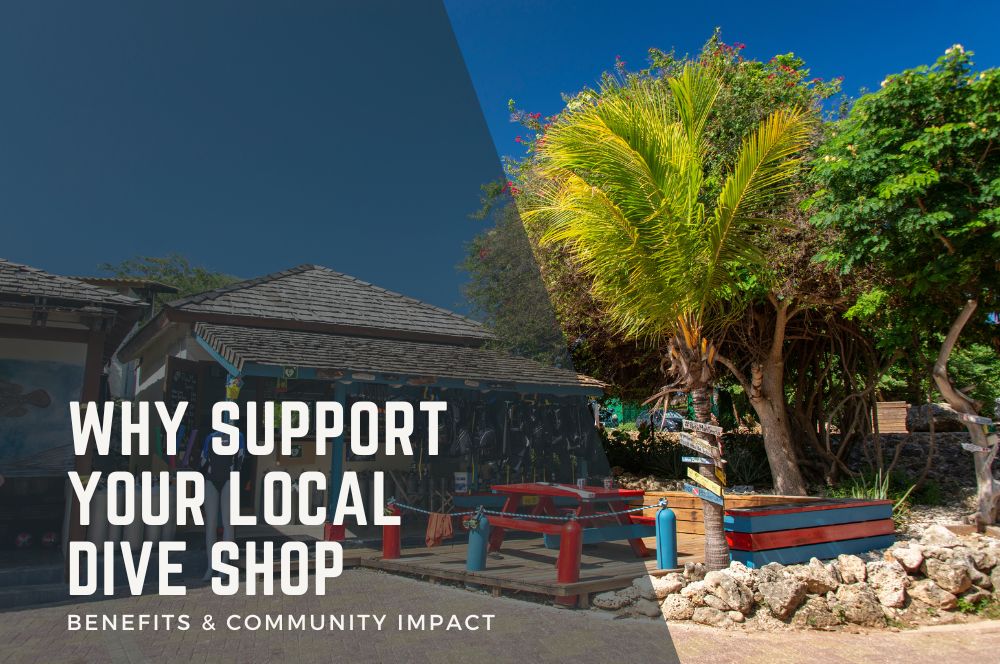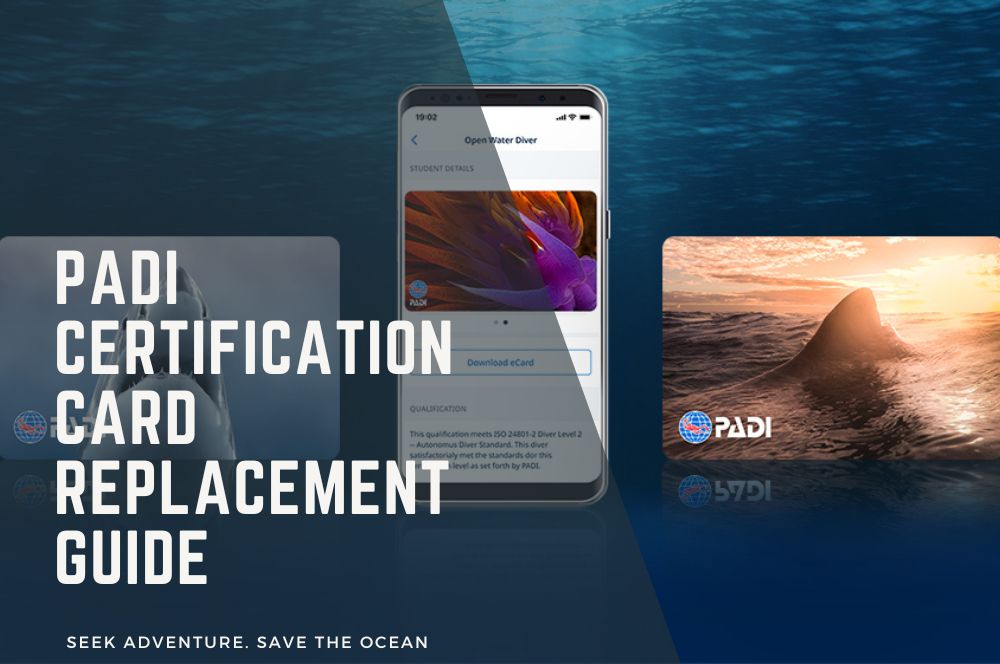You have 0 product(s) in your cart.
Abyss Scuba Diving
Din Vs Yoke: Which Scuba Regulator Is Right For You?

DIN vs Yoke: Which Scuba Regulator is for You?
Not sure which is right for you? This guide breaks down the differences, advantages, and best uses of each to help you make the right choice of first-stage regulator for your diving.
Quick Points
-
DIN has a threaded connection for high-pressure diving; Yoke has a clamp for easy attachment.
-
Yoke is popular with recreational scuba divers due to its ease of use and wide availability, especially in popular tourist diving destinations.
-
Both DIN and Yoke regulators can be converted, so you can use different setups based on your equipment and personal preference.

Scuba Regulators: DIN vs Yoke
A scuba regulator consists of two parts: the first stage regulator that connects to the tank and the second stage from which you breathe. This simple but crucial piece of gear, including scuba diving regulators, reduces the high-pressure air from your tank to a breathable pressure.
You have two choices for connecting your regulator to the tank: DIN and Yoke. These refer to how the first-stage regulator attaches to the tank valve. While they serve the same purpose, they can be very different in design and use. Knowing the differences helps you choose the right gear for your diving.
DIN vs Yoke Regulators
DIN regulators screw into the tank valve with a threaded connection, providing a secure and robust seal. This allows for higher cylinder pressures and is popular with tech divers and those diving in harsh conditions. Yoke regulators clamp onto the tank valve, making it quick and easy to attach, which is what many recreational divers prefer.
The choice between DIN and Yoke often comes down to personal preference and specific diving needs. Let’s look at their connection methods to see what’s different.
DIN Regulator Connection
DIN regulators have a threaded opening that screws into the cylinder valve. A threaded male connector screws into the female tank valve, providing a secure and reliable seal. Some models can go up to 300 bar; this connection is good for high-pressure use.
Some tanks have a DIN/Yoke valve, so you can switch between both. This versatility means you can use DIN regulators in many diving situations, making them more versatile.

Yoke Regulator Connection
Yoke first-stage regulators use a simple clamp to attach to the tank. The yoke regulator fits over the valve outlet and is secured with a screw, pushing the o-ring against the tank valve. This easy-to-use attachment makes yoke regulators popular with recreational divers.
The main o-ring in a yoke regulator setup is on the tank valve itself. The o-ring is exposed to wear and tear so needs to be inspected and maintained regularly to ensure a leak free seal.
Benefits of DIN Regulators
DIN first-stage regulators can handle higher pressures of up to 300 bar compared to 232 bar of yoke regulators. This makes them suitable for tech diving and high-pressure use. The threaded connection also reduces the risk of accidental disconnection and provides more safety during dives.
DIN regulators are preferred for cold water diving. Many models are environmentally sealed to prevent ice formation, so they will work reliably in sub-zero temperatures. This makes them a good option for divers who dive in harsh conditions.
DIN regulators are a good investment for new divers who want to future-proof their gear. They are compatible with advanced systems like the Avelo Dive System, which operates at higher pressures, so divers can use the latest technology.
Benefits of Yoke Regulators
Yoke regulators are easy to use, making them a good choice for beginners and casual divers. The simple clamp makes it quick and easy to attach, which is good for those with limited hand mobility. This is why yoke regulators are in rental tanks.
Yoke-compatible tanks are available at dive shops worldwide, making it convenient for travellers. In the Caribbean, Southeast Asia, or the US, yoke tanks are common, making it easy to find compatible gear.
Compatibility and Versatility
Modern scuba diving equipment is very versatile. Divers can use a DIN-to-Yoke converter to make their DIN regulators compatible with yoke tanks. You can switch between DIN and Yoke setup without buying new gear.
Adapters are available everywhere, so you can connect different regulators to different tank types and be always ready. This is very useful when travelling, as you can use the gear available at the local dive shop.
Using DIN Regulators with Yoke Tanks
Using a DIN regulator with yoke tanks is easy with the right adapters. These adapters are available and will connect a DIN regulator to a yoke cylinder valve smoothly. So divers can switch between DIN and yoke setups depending on the gear available.
DIN first-stage regulators versatility is important for divers who travel or dive in different locations. A yoke adapter will make sure you’re always ready to use the best gear available regardless of the dive centre’s equipment.

Yoke to DIN Conversion
Converting a yoke regulator to a DIN system is useful for divers adapting to different diving conditions. This is done using a DIN-to-yoke adapter with safe pressure ratings for a safe dive.
These adapters ensure compatibility and safety, so you can switch between the yoke and DIN systems seamlessly. This is good for divers who want to upgrade their gear without buying a new setup.
Join the Future of Scuba Diving with the Avelo Dive System
The Avelo Dive System is changing the way we dive. It combines buoyancy control into a lightweight Hydrotank so divers can achieve neutral buoyancy using water, not air. This eliminates the need for a traditional buoyancy control device (BCD), reduces instability, and makes it easier to maintain neutral buoyancy throughout the dive.
The Avelo system has 300 bar working pressure, so it has more gas capacity and longer dive time than traditional scuba tanks. It’s ideal for divers who value efficiency, stability and safety in their underwater adventures. So if you are a scuba diver looking at the future, then a DIN regulator is the right choice for you.

Regional Preference for DIN and Yoke Regulators
Scuba regulator preference varies by region. In the US, Mexico, and Southeast Asia, yoke regulators are common, so they are the standard for recreational diving. It’s because of compatibility with local diving gear and yoke-compatible tanks.
In Europe, DIN regulators are preferred, especially for high-pressure and technical diving. Although yoke regulators are popular in the region, many divers are switching to DIN systems for reliability and higher pressure resistance.
Safety Considerations for DIN and Yoke Regulators
Safety is key when choosing between DIN and yoke regulators. DIN regulators screw-in design prevents accidental disconnection, it’s a more secure connection. The O-ring in a DIN regulator is inside the regulator itself, protecting it from contaminants and reducing leak risk.
Yoke regulators have an exposed o-ring on the tank valve, making them more prone to wear and tear. Yoke valve connections are safe up to 232 bar but not as secure as DIN regulators in high-pressure situations.

Choose the Right Regulator for Your Diving Style
Choose your diving style and experience level when choosing a scuba regulator. Yoke regulators are more user-friendly, so they’re ideal for beginners and recreational divers. The easy attachment process and their widespread availability in popular diving areas make them more appealing.
A DIN regulator may be the better choice for technical diving or extreme conditions. Its higher-pressure capacity, more safety features, and compatibility with advanced systems like Avelo make it suitable for scuba divers thinking about diving as a long term activity.
Conclusion
In summary, both DIN and Yoke first-stage regulators have their advantages and use cases. DIN regulators have higher pressure capacity and more safety, so they are good for technical and cold-water diving. Yoke regulators, with their ease of use and wide availability, are perfect for recreational divers and those who value convenience.
Choosing the right regulator ultimately depends on your diving needs and preferences. By knowing the differences and benefits of each system, you can make an informed decision that will enhance your underwater adventure. Dive safe and enjoy the best technology available.
FAQs
What’s the main difference between DIN and Yoke regulators?
The main difference between DIN and Yoke first-stage regulators is the connection method: DIN regulators screw into the tank valve while Yoke regulators clamp onto the valve. This affects compatibility and usability.
Which one is better for high-pressure diving?
DIN regulators are better for high-pressure diving since they can handle up to 300 bar, while Yoke regulators can only handle up to 232 bar. They’re also a more reliable choice for deep diving.
Is Yoke regulators easier to use?
Yes, Yoke regulators are easier to use, so they are popular with recreational divers and beginners.
Can I convert the Yoke regulator to a DIN system?
Using adapters, you can convert a Yoke regulator to a DIN system. This will ensure compatibility and maintain a safe pressure rating.
Why is the Avelo Dive System innovative?
Avelo Dive System is innovative because it combines buoyancy control with a lightweight Hydrotank, eliminating the need for traditional buoyancy control devices (BCD) and improving stability and safety while diving.
Recent Posts




